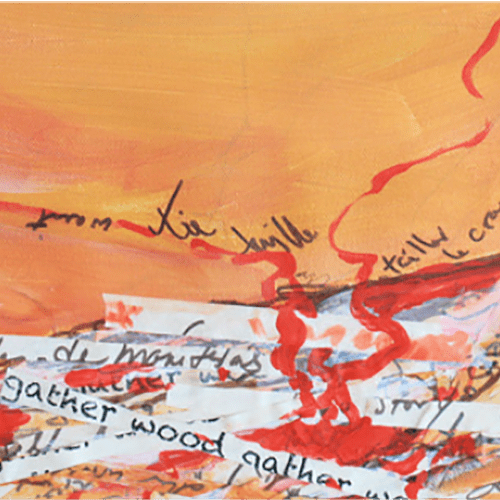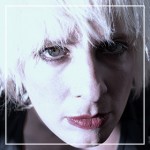Anthropologist and writer Helen Faller interviews Susan Ossman, Artistic Director of the Moving Matters Traveling Workshop and professor of Anthropology at University of California, Riverside.
Helen: What is the Moving Matters Traveling Workshop?
Susan: The MMTW is a collective of artists and scholars who develop art together based on their shared experience of living in several countries. The project started in 2013 at a seminar where anthropologists and artists developed “creative responses” to my book Moving Matters, Paths of Serial Migration. Since then we have met in changing locations to address topics related to migration and mobility from our perspectives as “serial migrants” in art, exhibitions and performances. The MMTW grows through a process of progressive “inhabitations.” Just like a serial migrant, it settles into one country after another. We have traveled to California, France, the Netherlands and Romania. Berlin is coming up in June.
What do you mean by serial migrant?
The concept of serial migration is one I proposed in 2004, explored with other serial migrant scholars and artists in The Places We Share (Lexington 2007) and then developed in detail in the fieldwork that produced Moving Matters.
Serial migrants are people who have repeated the experience of migrating and settling into a new country. Much has been written about the “betweeness” of immigrants caught between two countries. But what happens when the immigrant moves on? How does a third move beyond “immigration” alter the subject and her sense of self? This is becoming increasingly common. Serial migrants are shaped by several different regimes of identification. They often shift class positions as they migrate. This poses a series of fruitful conundrums for social theory.
I argue that different migratory paths produce distinctly different forms of subjects; a kind of political choreography is emerging in which access to movement or requirements to move in certain ways produce forms of cultural and social diversity that are not captured by static categories of identity. The work of the MMTW contributes to opening up new horizons for imagining this emerging social world.
What do the artists and scholars of the MMTW do that relates to their status as serial migrants?
One thing I observed in my research was that, rather than talking about becoming “integrated,” serial migrants adopted a project orientation to feeling “involved” and “at home.” So the MMTW generates a social milieu of people who are temporarily involved and at home in the workshop space.
The workshop focuses on the common path of its participants, creating a setting that enables critical thought about the nature of belonging, community, and identity. Because none of these is taken for granted.
Embracing the identity of “serial migrant” in the “artificial,” mobile milieu of the project has proven to be not only intellectually provocative, but also emotionally significant for artists and artist/anthropologists born in different countries and into various social strata. With the MMTW, serial migrants find a space of commonality. Embodied, performative, aesthetic, and affective work about the specific routes of individual participants is encouraged by and interwoven with collaborative reflections and productions. Each workshop includes a new mix of participants and brings in new participants.
Who are MMTW members?
Participants have been labeled refugees or political exiles, love migrants or foreign students, economic immigrants, expats or resident aliens. They have been called cosmopolitans or global nomads. Some of the artists who will join the workshop in Berlin are currently refugees. Such categories can obscure alternate identities and the way serial migrants pass not only through multiple categories, but several ways of construing identities. Getting a sense of who a serial migrant is requires both listening to his or her story and recognizing that multiple regimes of value and identification have shaped him. These are frameworks that we might study, but that remain outside our own experience.
The art of the MMTW includes diverse languages, forms of movement, palettes, and rhythms. We bring these to our work as serial migrants, not just as representatives of some cultural milieu we represent. So cultural repertoires are not objectified, but associated in a lively way. As serial migrants we naturally work amid several repertoires, which is a subject of study in itself. Our art tends to draw attention to path-making processes. For instance, performances always literally move the audience through several spaces, as this film of us preparing for a performance shows.
We think that our work is distinctive because it is the result not only of reflections on individual migratory experiences, but the way these have been told, interwoven, and conceptualized through the MMTW’s sustained program of collaborative research.
How do you find sites and collaborators?
A lot depends on individual initiative and chance. Sometimes the director of a cultural center hears about the project and invites us to develop a workshop. Guillaume Lasserre heard about the MMTW and invited us to perform at the Pavillon Vendome in Clichy. Olga Sezneva got the Allard Pierson Museum of Mediterranean Antiquities in Amsterdam interested in the project. Alec Balesecu was an early participant who drew Ioana Paun into the project to develop “My Story/Your History” in Bucharest, leading to a participatory intervention called “Map quest” which we further developed in a Riverside, California performance in 2016.

Mapquest: a participatory moment during a 2016 performance in Riverside, California
Financing the MMTW is challenging. We don’t charge for our exhibitions or performances. We have received support from our universities but our activities don’t fit grant cycles. Projects evolve too fast. Some individual donors have been extremely generous.
Tell me more about the anthropology/art connection.
I am a visual artist as well as an anthropologist (Ossman 2014). I’ve devised a variety of collaborative projects that cross art practice and anthropological research in different ways (Allison and Ossman 2014; Ossman 2016). Right now, I’m preparing an exhibition called “Wissen/ Schaffen” (knowledge/making) based on participant observation at the Wissenschaftskolleg in Berlin.
The depth of engagement and continuity over several years of the MMTW is nothing new for anthropologist. It is much less common in art, even at its most collaborative and participatory. The fieldwork-like processes of iteration across sites is extremely fruitful for developing individually authored pieces as well as collaborative work.
For me, this process has encouraged permeability between art and scholarship. My installation “Mediterranean Sea Scroll, which includes a bibliography while “Gather Wood, Gather words” plays with conventions of museum texts.
My Mediterranean Sea Scroll, by Susan Ossman
An installation of “Gather Wood, Gather Words” by Susan Ossman at the Allard Pierson Museum of Mediterranean Antiquities in Amsterdam (Read the texts here.)
Why did you want to curate a workshop in Berlin?
Border walls are multiplying at a frightening pace. So is the number of people displaced by war, famine, global warming, and economic crises. These people need walls. Berlin is the ideal site from which to contemplate walls as barriers and protection, given the symbolism of the Berlin Wall and the number of people fleeing war in the Middle East and Asia who have found refuge in Germany. We’re honored to be working with Pastor Thomas Jeutner at the Kapelle der Versöhnung and Lisa Strehmann of the Refugee Office of Protestant Dinary, Berlin North East.
The Chapel of Reconciliation on Berlin’s former border zone is an intensely symbolic, immensely moving site. It is part of the Berlin Wall Monument. The inner sanctuary is protected by an immense earth wall composed of the remains of the church that formerly stood on the site before the DDR destroyed it in 1985. The outer walls are open to the surrounding landscape, which was once the border zone between the two Germanys. It will be an amazingly complex and challenging space to develop an exhibition and performance.
How will meeting in Berlin advance the goals of the MMTW?
The chapel receives about 1,500 visitors each day. They come from all over the world to remember “The Wall.” We think that they will be especially open to experiencing art that ties this history to current events. Being able to develop an exhibition and performance of this magnitude brings our project to a new level of public awareness. Through our art will share our “moving” perspectives on walls as borders, shelters, and sanctuaries. The MMTW underscores how “paths” make us all. It demonstrates that recognizing common paths can be a source of global solidarity.
This seems like an expensive endeavor. How do you finance it?
Our performances and exhibitions are always free and open to the public. We don’t make money from any ticket sales. And our local collaborators provide space and logistical support. Sometimes they’ll pay for printing or sandwiches
Those of us who have academic positions or make a solid living from our art pay our own way. Sometimes we even cross-finance. So I may buy a painting from a fellow MMTW member so that she can purchase a plane ticket to attend a workshop. But as we gain momentum, we are coming to realize that this self-financing model isn’t sustainable. So we’re working on creating a fund and for this workshop we’ve designed an indiegogo campaign. Is it okay if I include the link?
Certainly. I think Allegra Lab’s readers might be interested in supporting MMTW’s workshop, since your explorations speak so closely to many of our experiences.
Support can also come in the form of sharing the link with friends, if you’re not in a position to make a donation yourself. Every dollar, every euro counts. Really.
Thanks for your time, Susan.
Thanks for your time too, Helen. One more thing. Allegra Lab readers should stay tuned for upcoming pieces by three other MMTW members. They will discuss the mutually generative relationship between scholarship and art, offering a glimpse into the making of MMTW’s “Walls” at the Wall Berlin Workshop.
Susan Ossman (Creative Director and Artistic Producer) is an anthropologist and an artist who has made her home in France, Morocco, the UK and the US. She is the author of books on globalization, migration, media and aesthetics. Susan has developed cross-disciplinary collaborative art projects that include On the Line, Lifeworks and the Moving Matters Traveling Workshop. Her paintings, installations and multi-media work developed in the course of these migrations have been exhibited in Europe and the US. She is Professor of Anthropology and Global Studies at University of California, Riverside.










